Human Physiology: Analysis of Rugby Player and Skier Performance
VerifiedAdded on 2023/01/03
|9
|2066
|30
Report
AI Summary
This report presents two case studies focusing on the human physiology of athletes in different sports. The first case study examines a rugby player, analyzing their training load, energy consumption, and physiological changes during the pre-season. The study highlights the importance of a balanced diet and its impact on performance. The second case study investigates cross-country skiers, comparing a simulated VO2 max test protocol with a traditional test. The report discusses the high VO2 max values associated with cross-country skiing, emphasizing the sport's demands on both aerobic and anaerobic systems. It also highlights the importance of understanding the physiological demands of each sport to optimize training and performance. The report concludes by emphasizing the need for further research to fully understand the physiological adaptations of athletes in these sports.
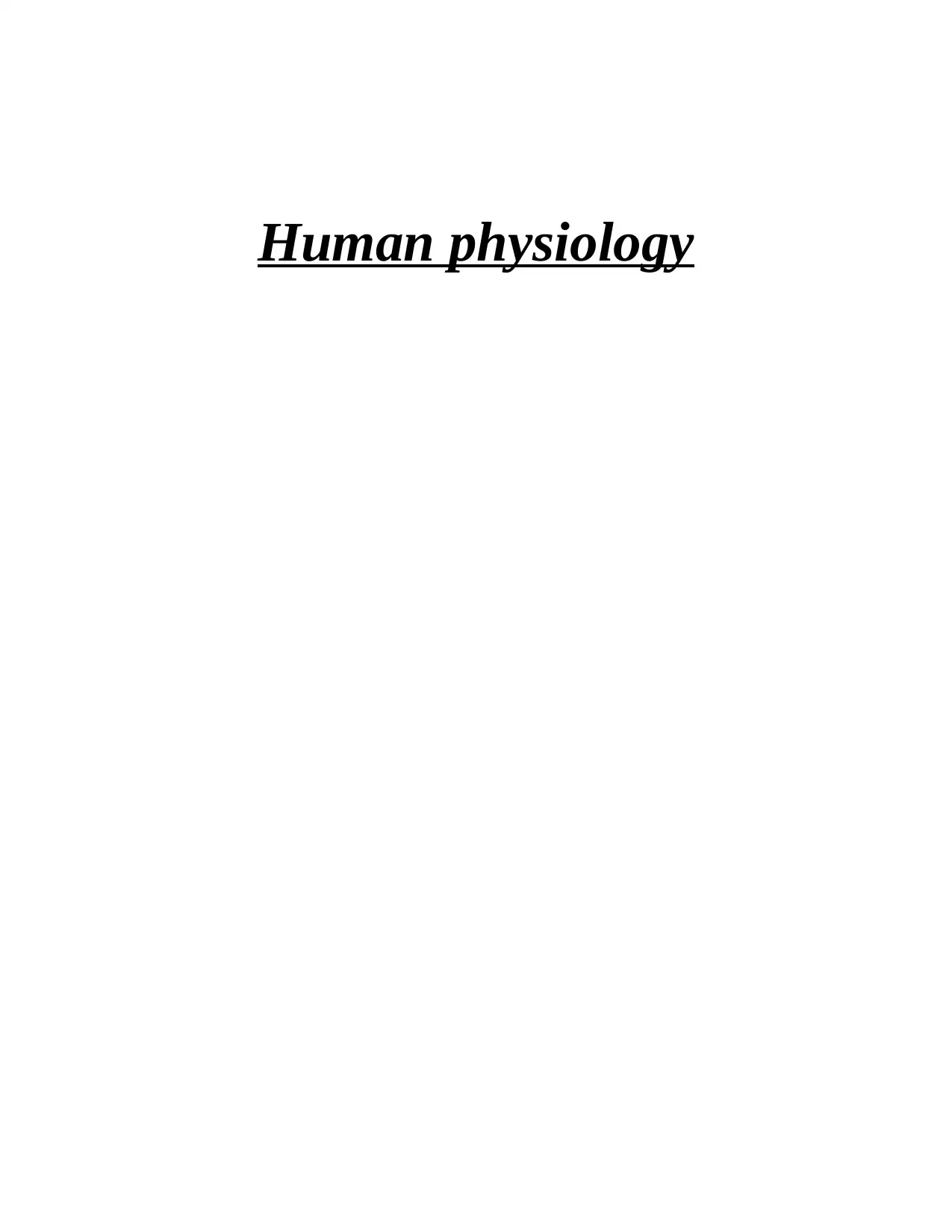
Human physiology
Paraphrase This Document
Need a fresh take? Get an instant paraphrase of this document with our AI Paraphraser
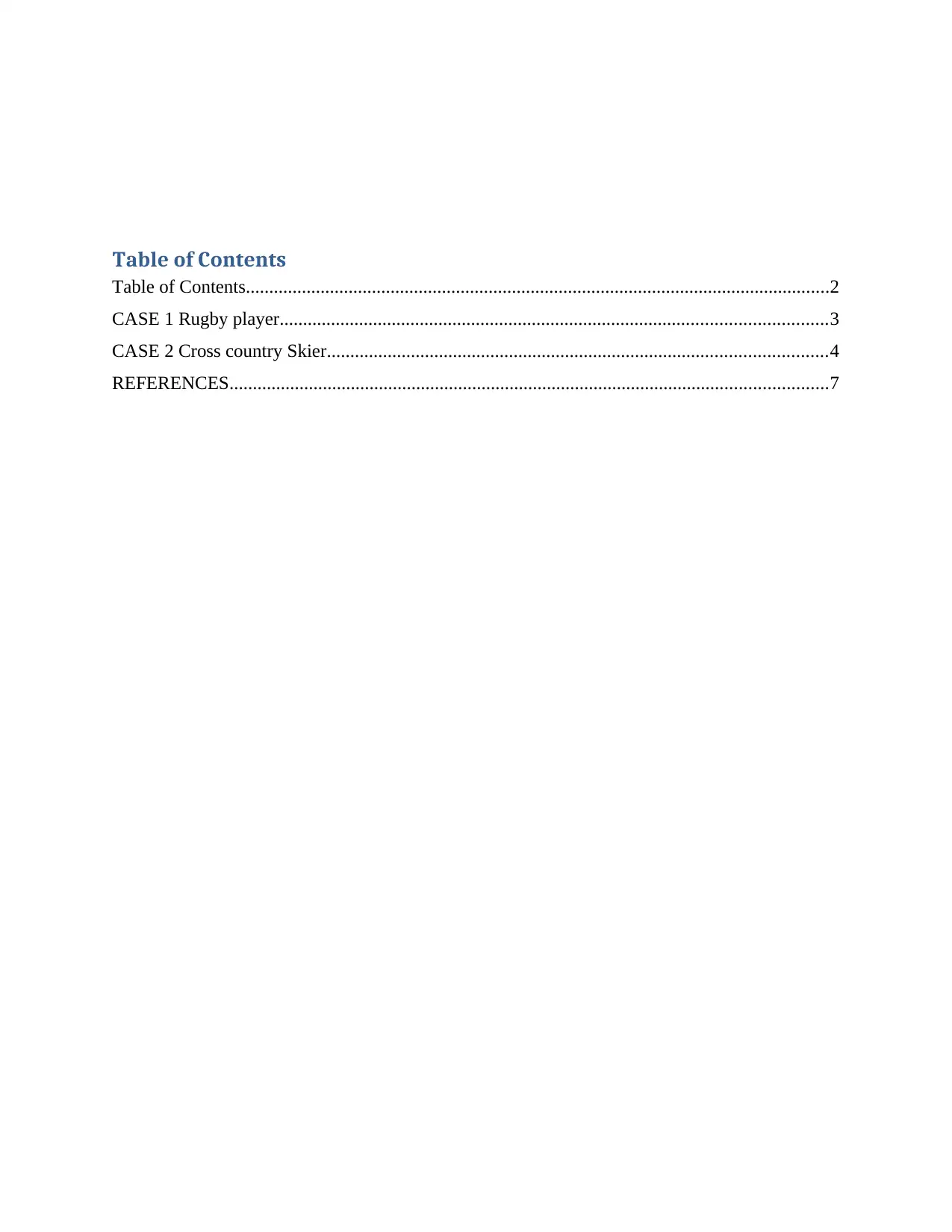
Table of Contents
Table of Contents.............................................................................................................................2
CASE 1 Rugby player.....................................................................................................................3
CASE 2 Cross country Skier...........................................................................................................4
REFERENCES................................................................................................................................7
Table of Contents.............................................................................................................................2
CASE 1 Rugby player.....................................................................................................................3
CASE 2 Cross country Skier...........................................................................................................4
REFERENCES................................................................................................................................7
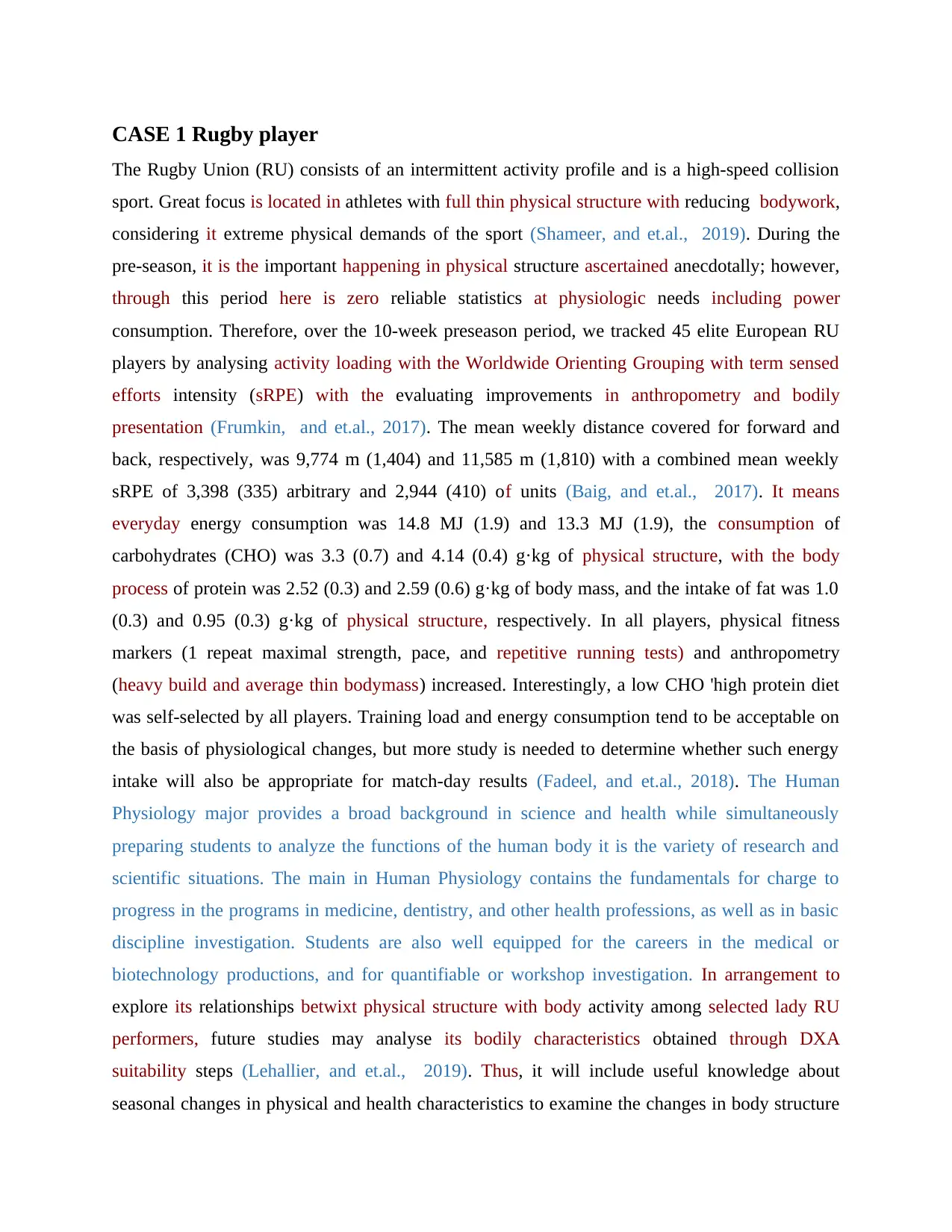
CASE 1 Rugby player
The Rugby Union (RU) consists of an intermittent activity profile and is a high-speed collision
sport. Great focus is located in athletes with full thin physical structure with reducing bodywork,
considering it extreme physical demands of the sport (Shameer, and et.al., 2019). During the
pre-season, it is the important happening in physical structure ascertained anecdotally; however,
through this period here is zero reliable statistics at physiologic needs including power
consumption. Therefore, over the 10-week preseason period, we tracked 45 elite European RU
players by analysing activity loading with the Worldwide Orienting Grouping with term sensed
efforts intensity (sRPE) with the evaluating improvements in anthropometry and bodily
presentation (Frumkin, and et.al., 2017). The mean weekly distance covered for forward and
back, respectively, was 9,774 m (1,404) and 11,585 m (1,810) with a combined mean weekly
sRPE of 3,398 (335) arbitrary and 2,944 (410) of units (Baig, and et.al., 2017). It means
everyday energy consumption was 14.8 MJ (1.9) and 13.3 MJ (1.9), the consumption of
carbohydrates (CHO) was 3.3 (0.7) and 4.14 (0.4) g·kg of physical structure, with the body
process of protein was 2.52 (0.3) and 2.59 (0.6) g·kg of body mass, and the intake of fat was 1.0
(0.3) and 0.95 (0.3) g·kg of physical structure, respectively. In all players, physical fitness
markers (1 repeat maximal strength, pace, and repetitive running tests) and anthropometry
(heavy build and average thin bodymass) increased. Interestingly, a low CHO 'high protein diet
was self-selected by all players. Training load and energy consumption tend to be acceptable on
the basis of physiological changes, but more study is needed to determine whether such energy
intake will also be appropriate for match-day results (Fadeel, and et.al., 2018). The Human
Physiology major provides a broad background in science and health while simultaneously
preparing students to analyze the functions of the human body it is the variety of research and
scientific situations. The main in Human Physiology contains the fundamentals for charge to
progress in the programs in medicine, dentistry, and other health professions, as well as in basic
discipline investigation. Students are also well equipped for the careers in the medical or
biotechnology productions, and for quantifiable or workshop investigation. In arrangement to
explore its relationships betwixt physical structure with body activity among selected lady RU
performers, future studies may analyse its bodily characteristics obtained through DXA
suitability steps (Lehallier, and et.al., 2019). Thus, it will include useful knowledge about
seasonal changes in physical and health characteristics to examine the changes in body structure
The Rugby Union (RU) consists of an intermittent activity profile and is a high-speed collision
sport. Great focus is located in athletes with full thin physical structure with reducing bodywork,
considering it extreme physical demands of the sport (Shameer, and et.al., 2019). During the
pre-season, it is the important happening in physical structure ascertained anecdotally; however,
through this period here is zero reliable statistics at physiologic needs including power
consumption. Therefore, over the 10-week preseason period, we tracked 45 elite European RU
players by analysing activity loading with the Worldwide Orienting Grouping with term sensed
efforts intensity (sRPE) with the evaluating improvements in anthropometry and bodily
presentation (Frumkin, and et.al., 2017). The mean weekly distance covered for forward and
back, respectively, was 9,774 m (1,404) and 11,585 m (1,810) with a combined mean weekly
sRPE of 3,398 (335) arbitrary and 2,944 (410) of units (Baig, and et.al., 2017). It means
everyday energy consumption was 14.8 MJ (1.9) and 13.3 MJ (1.9), the consumption of
carbohydrates (CHO) was 3.3 (0.7) and 4.14 (0.4) g·kg of physical structure, with the body
process of protein was 2.52 (0.3) and 2.59 (0.6) g·kg of body mass, and the intake of fat was 1.0
(0.3) and 0.95 (0.3) g·kg of physical structure, respectively. In all players, physical fitness
markers (1 repeat maximal strength, pace, and repetitive running tests) and anthropometry
(heavy build and average thin bodymass) increased. Interestingly, a low CHO 'high protein diet
was self-selected by all players. Training load and energy consumption tend to be acceptable on
the basis of physiological changes, but more study is needed to determine whether such energy
intake will also be appropriate for match-day results (Fadeel, and et.al., 2018). The Human
Physiology major provides a broad background in science and health while simultaneously
preparing students to analyze the functions of the human body it is the variety of research and
scientific situations. The main in Human Physiology contains the fundamentals for charge to
progress in the programs in medicine, dentistry, and other health professions, as well as in basic
discipline investigation. Students are also well equipped for the careers in the medical or
biotechnology productions, and for quantifiable or workshop investigation. In arrangement to
explore its relationships betwixt physical structure with body activity among selected lady RU
performers, future studies may analyse its bodily characteristics obtained through DXA
suitability steps (Lehallier, and et.al., 2019). Thus, it will include useful knowledge about
seasonal changes in physical and health characteristics to examine the changes in body structure
⊘ This is a preview!⊘
Do you want full access?
Subscribe today to unlock all pages.

Trusted by 1+ million students worldwide
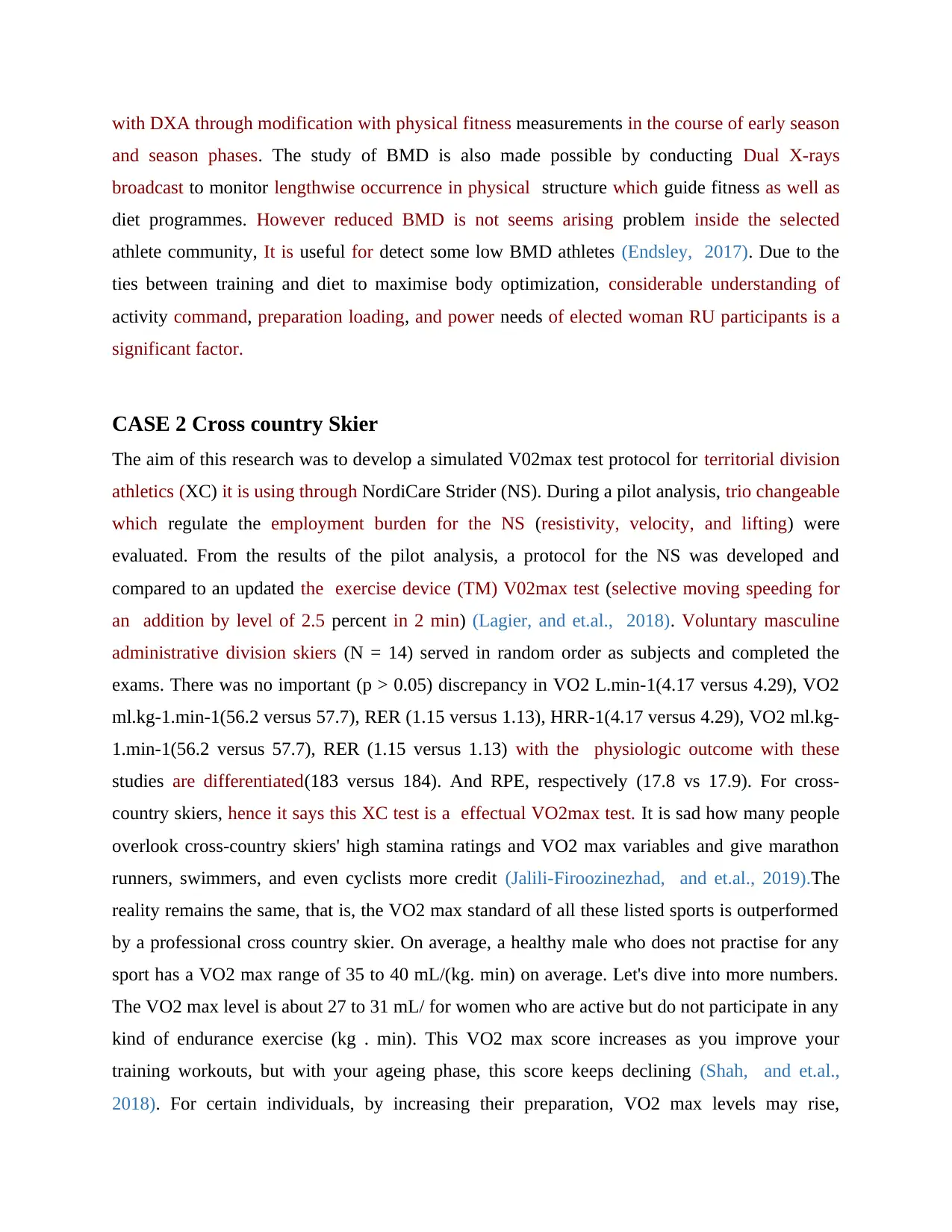
with DXA through modification with physical fitness measurements in the course of early season
and season phases. The study of BMD is also made possible by conducting Dual X-rays
broadcast to monitor lengthwise occurrence in physical structure which guide fitness as well as
diet programmes. However reduced BMD is not seems arising problem inside the selected
athlete community, It is useful for detect some low BMD athletes (Endsley, 2017). Due to the
ties between training and diet to maximise body optimization, considerable understanding of
activity command, preparation loading, and power needs of elected woman RU participants is a
significant factor.
CASE 2 Cross country Skier
The aim of this research was to develop a simulated V02max test protocol for territorial division
athletics (XC) it is using through NordiCare Strider (NS). During a pilot analysis, trio changeable
which regulate the employment burden for the NS (resistivity, velocity, and lifting) were
evaluated. From the results of the pilot analysis, a protocol for the NS was developed and
compared to an updated the exercise device (TM) V02max test (selective moving speeding for
an addition by level of 2.5 percent in 2 min) (Lagier, and et.al., 2018). Voluntary masculine
administrative division skiers (N = 14) served in random order as subjects and completed the
exams. There was no important (p > 0.05) discrepancy in VO2 L.min-1(4.17 versus 4.29), VO2
ml.kg-1.min-1(56.2 versus 57.7), RER (1.15 versus 1.13), HRR-1(4.17 versus 4.29), VO2 ml.kg-
1.min-1(56.2 versus 57.7), RER (1.15 versus 1.13) with the physiologic outcome with these
studies are differentiated(183 versus 184). And RPE, respectively (17.8 vs 17.9). For cross-
country skiers, hence it says this XC test is a effectual VO2max test. It is sad how many people
overlook cross-country skiers' high stamina ratings and VO2 max variables and give marathon
runners, swimmers, and even cyclists more credit (Jalili-Firoozinezhad, and et.al., 2019).The
reality remains the same, that is, the VO2 max standard of all these listed sports is outperformed
by a professional cross country skier. On average, a healthy male who does not practise for any
sport has a VO2 max range of 35 to 40 mL/(kg. min) on average. Let's dive into more numbers.
The VO2 max level is about 27 to 31 mL/ for women who are active but do not participate in any
kind of endurance exercise (kg . min). This VO2 max score increases as you improve your
training workouts, but with your ageing phase, this score keeps declining (Shah, and et.al.,
2018). For certain individuals, by increasing their preparation, VO2 max levels may rise,
and season phases. The study of BMD is also made possible by conducting Dual X-rays
broadcast to monitor lengthwise occurrence in physical structure which guide fitness as well as
diet programmes. However reduced BMD is not seems arising problem inside the selected
athlete community, It is useful for detect some low BMD athletes (Endsley, 2017). Due to the
ties between training and diet to maximise body optimization, considerable understanding of
activity command, preparation loading, and power needs of elected woman RU participants is a
significant factor.
CASE 2 Cross country Skier
The aim of this research was to develop a simulated V02max test protocol for territorial division
athletics (XC) it is using through NordiCare Strider (NS). During a pilot analysis, trio changeable
which regulate the employment burden for the NS (resistivity, velocity, and lifting) were
evaluated. From the results of the pilot analysis, a protocol for the NS was developed and
compared to an updated the exercise device (TM) V02max test (selective moving speeding for
an addition by level of 2.5 percent in 2 min) (Lagier, and et.al., 2018). Voluntary masculine
administrative division skiers (N = 14) served in random order as subjects and completed the
exams. There was no important (p > 0.05) discrepancy in VO2 L.min-1(4.17 versus 4.29), VO2
ml.kg-1.min-1(56.2 versus 57.7), RER (1.15 versus 1.13), HRR-1(4.17 versus 4.29), VO2 ml.kg-
1.min-1(56.2 versus 57.7), RER (1.15 versus 1.13) with the physiologic outcome with these
studies are differentiated(183 versus 184). And RPE, respectively (17.8 vs 17.9). For cross-
country skiers, hence it says this XC test is a effectual VO2max test. It is sad how many people
overlook cross-country skiers' high stamina ratings and VO2 max variables and give marathon
runners, swimmers, and even cyclists more credit (Jalili-Firoozinezhad, and et.al., 2019).The
reality remains the same, that is, the VO2 max standard of all these listed sports is outperformed
by a professional cross country skier. On average, a healthy male who does not practise for any
sport has a VO2 max range of 35 to 40 mL/(kg. min) on average. Let's dive into more numbers.
The VO2 max level is about 27 to 31 mL/ for women who are active but do not participate in any
kind of endurance exercise (kg . min). This VO2 max score increases as you improve your
training workouts, but with your ageing phase, this score keeps declining (Shah, and et.al.,
2018). For certain individuals, by increasing their preparation, VO2 max levels may rise,
Paraphrase This Document
Need a fresh take? Get an instant paraphrase of this document with our AI Paraphraser
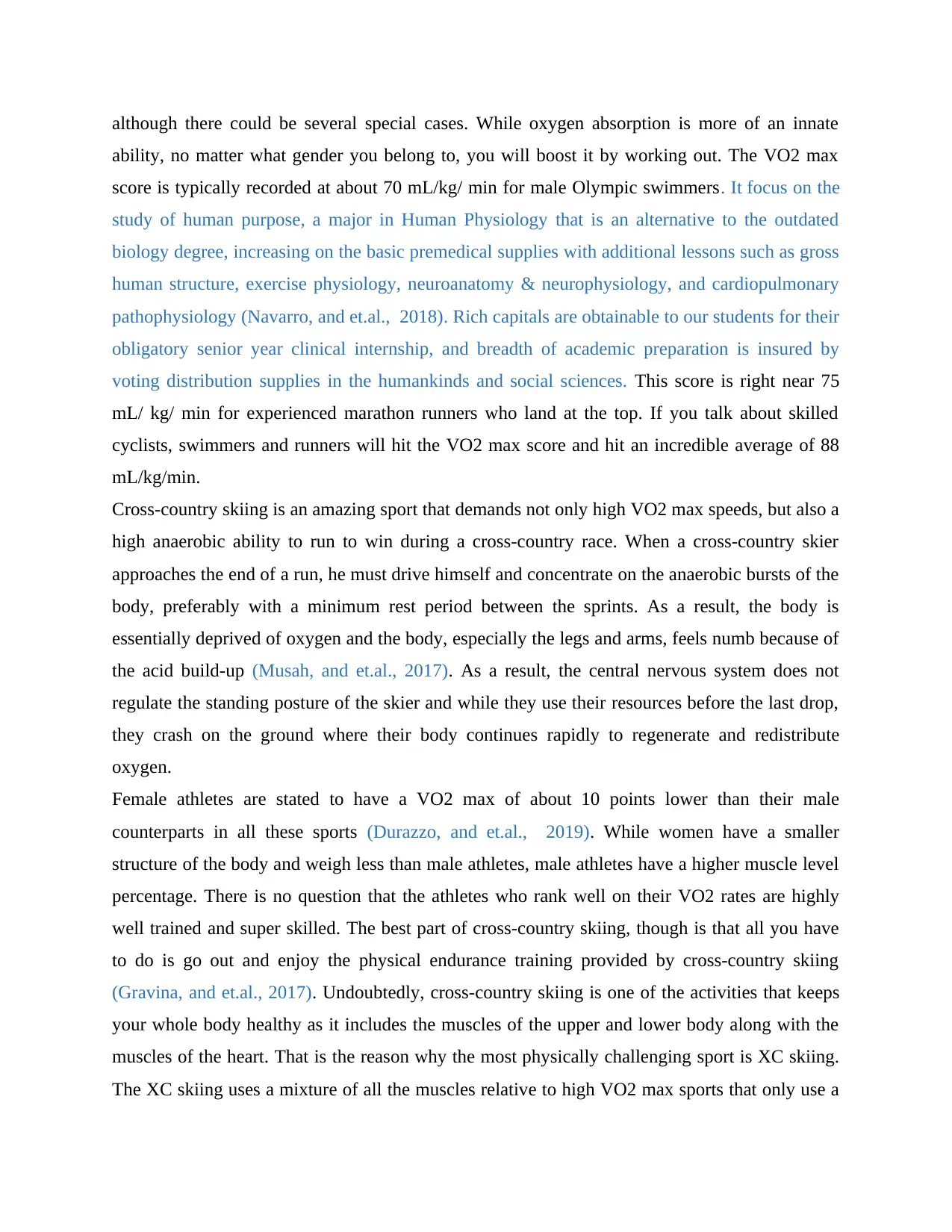
although there could be several special cases. While oxygen absorption is more of an innate
ability, no matter what gender you belong to, you will boost it by working out. The VO2 max
score is typically recorded at about 70 mL/kg/ min for male Olympic swimmers. It focus on the
study of human purpose, a major in Human Physiology that is an alternative to the outdated
biology degree, increasing on the basic premedical supplies with additional lessons such as gross
human structure, exercise physiology, neuroanatomy & neurophysiology, and cardiopulmonary
pathophysiology (Navarro, and et.al., 2018). Rich capitals are obtainable to our students for their
obligatory senior year clinical internship, and breadth of academic preparation is insured by
voting distribution supplies in the humankinds and social sciences. This score is right near 75
mL/ kg/ min for experienced marathon runners who land at the top. If you talk about skilled
cyclists, swimmers and runners will hit the VO2 max score and hit an incredible average of 88
mL/kg/min.
Cross-country skiing is an amazing sport that demands not only high VO2 max speeds, but also a
high anaerobic ability to run to win during a cross-country race. When a cross-country skier
approaches the end of a run, he must drive himself and concentrate on the anaerobic bursts of the
body, preferably with a minimum rest period between the sprints. As a result, the body is
essentially deprived of oxygen and the body, especially the legs and arms, feels numb because of
the acid build-up (Musah, and et.al., 2017). As a result, the central nervous system does not
regulate the standing posture of the skier and while they use their resources before the last drop,
they crash on the ground where their body continues rapidly to regenerate and redistribute
oxygen.
Female athletes are stated to have a VO2 max of about 10 points lower than their male
counterparts in all these sports (Durazzo, and et.al., 2019). While women have a smaller
structure of the body and weigh less than male athletes, male athletes have a higher muscle level
percentage. There is no question that the athletes who rank well on their VO2 rates are highly
well trained and super skilled. The best part of cross-country skiing, though is that all you have
to do is go out and enjoy the physical endurance training provided by cross-country skiing
(Gravina, and et.al., 2017). Undoubtedly, cross-country skiing is one of the activities that keeps
your whole body healthy as it includes the muscles of the upper and lower body along with the
muscles of the heart. That is the reason why the most physically challenging sport is XC skiing.
The XC skiing uses a mixture of all the muscles relative to high VO2 max sports that only use a
ability, no matter what gender you belong to, you will boost it by working out. The VO2 max
score is typically recorded at about 70 mL/kg/ min for male Olympic swimmers. It focus on the
study of human purpose, a major in Human Physiology that is an alternative to the outdated
biology degree, increasing on the basic premedical supplies with additional lessons such as gross
human structure, exercise physiology, neuroanatomy & neurophysiology, and cardiopulmonary
pathophysiology (Navarro, and et.al., 2018). Rich capitals are obtainable to our students for their
obligatory senior year clinical internship, and breadth of academic preparation is insured by
voting distribution supplies in the humankinds and social sciences. This score is right near 75
mL/ kg/ min for experienced marathon runners who land at the top. If you talk about skilled
cyclists, swimmers and runners will hit the VO2 max score and hit an incredible average of 88
mL/kg/min.
Cross-country skiing is an amazing sport that demands not only high VO2 max speeds, but also a
high anaerobic ability to run to win during a cross-country race. When a cross-country skier
approaches the end of a run, he must drive himself and concentrate on the anaerobic bursts of the
body, preferably with a minimum rest period between the sprints. As a result, the body is
essentially deprived of oxygen and the body, especially the legs and arms, feels numb because of
the acid build-up (Musah, and et.al., 2017). As a result, the central nervous system does not
regulate the standing posture of the skier and while they use their resources before the last drop,
they crash on the ground where their body continues rapidly to regenerate and redistribute
oxygen.
Female athletes are stated to have a VO2 max of about 10 points lower than their male
counterparts in all these sports (Durazzo, and et.al., 2019). While women have a smaller
structure of the body and weigh less than male athletes, male athletes have a higher muscle level
percentage. There is no question that the athletes who rank well on their VO2 rates are highly
well trained and super skilled. The best part of cross-country skiing, though is that all you have
to do is go out and enjoy the physical endurance training provided by cross-country skiing
(Gravina, and et.al., 2017). Undoubtedly, cross-country skiing is one of the activities that keeps
your whole body healthy as it includes the muscles of the upper and lower body along with the
muscles of the heart. That is the reason why the most physically challenging sport is XC skiing.
The XC skiing uses a mixture of all the muscles relative to high VO2 max sports that only use a
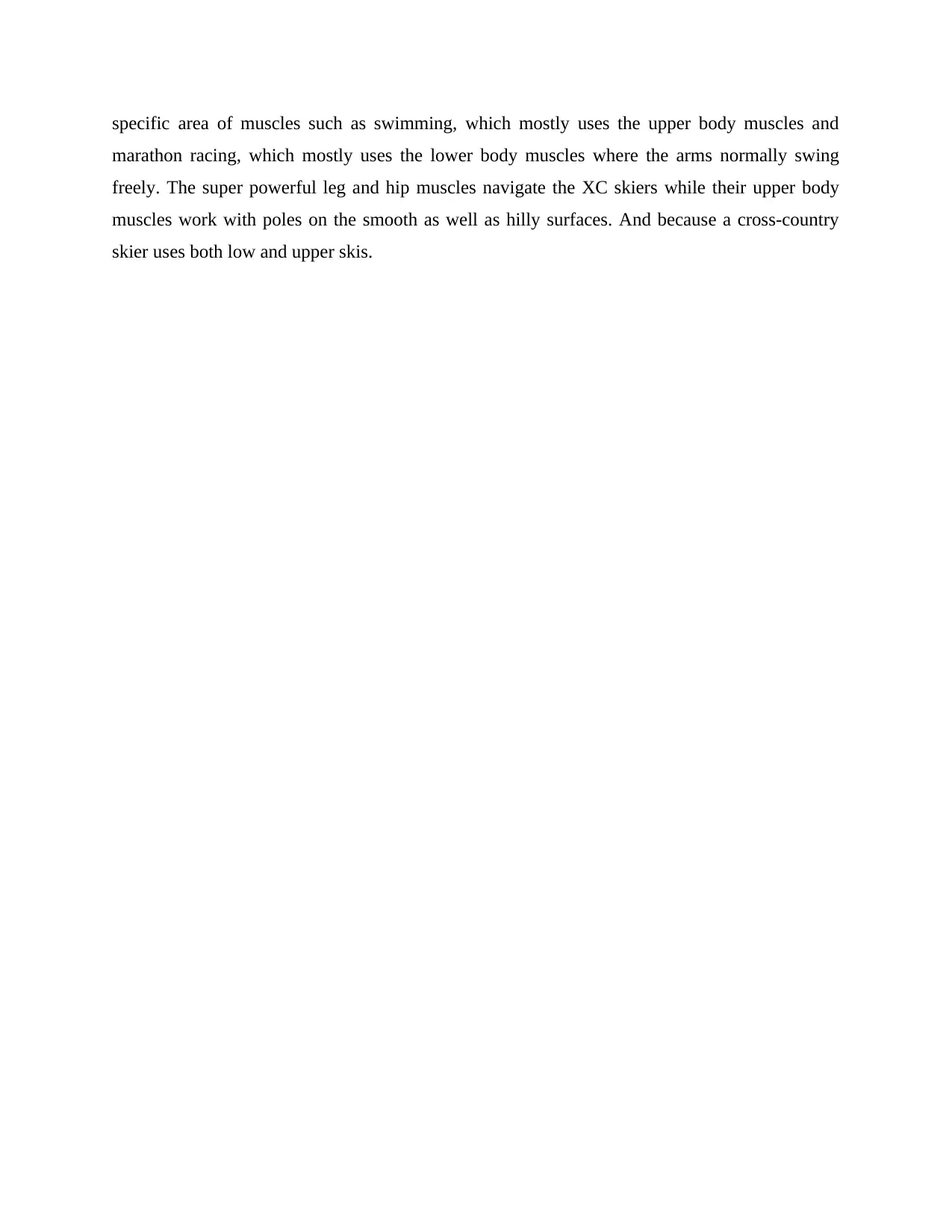
specific area of muscles such as swimming, which mostly uses the upper body muscles and
marathon racing, which mostly uses the lower body muscles where the arms normally swing
freely. The super powerful leg and hip muscles navigate the XC skiers while their upper body
muscles work with poles on the smooth as well as hilly surfaces. And because a cross-country
skier uses both low and upper skis.
marathon racing, which mostly uses the lower body muscles where the arms normally swing
freely. The super powerful leg and hip muscles navigate the XC skiers while their upper body
muscles work with poles on the smooth as well as hilly surfaces. And because a cross-country
skier uses both low and upper skis.
⊘ This is a preview!⊘
Do you want full access?
Subscribe today to unlock all pages.

Trusted by 1+ million students worldwide
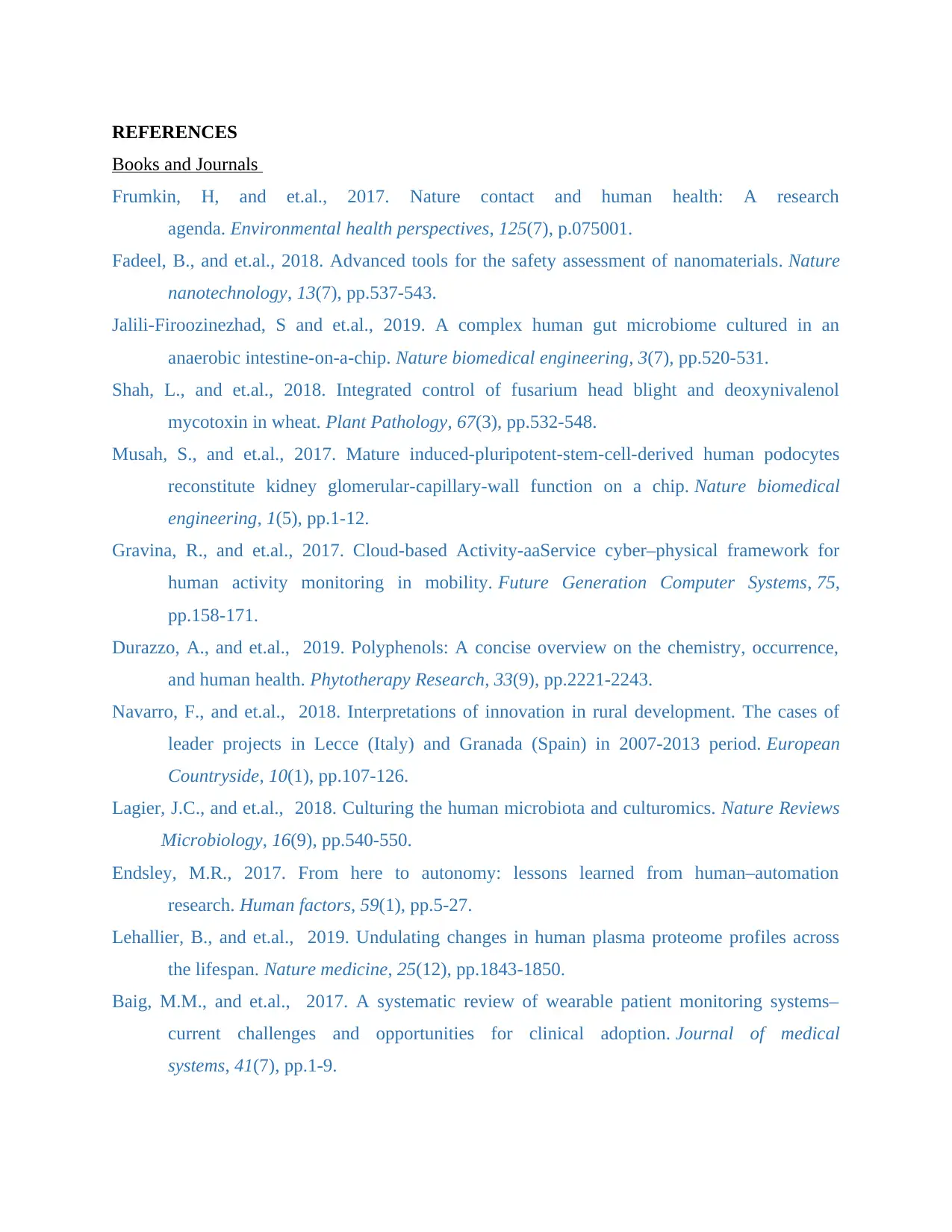
REFERENCES
Books and Journals
Frumkin, H, and et.al., 2017. Nature contact and human health: A research
agenda. Environmental health perspectives, 125(7), p.075001.
Fadeel, B., and et.al., 2018. Advanced tools for the safety assessment of nanomaterials. Nature
nanotechnology, 13(7), pp.537-543.
Jalili-Firoozinezhad, S and et.al., 2019. A complex human gut microbiome cultured in an
anaerobic intestine-on-a-chip. Nature biomedical engineering, 3(7), pp.520-531.
Shah, L., and et.al., 2018. Integrated control of fusarium head blight and deoxynivalenol
mycotoxin in wheat. Plant Pathology, 67(3), pp.532-548.
Musah, S., and et.al., 2017. Mature induced-pluripotent-stem-cell-derived human podocytes
reconstitute kidney glomerular-capillary-wall function on a chip. Nature biomedical
engineering, 1(5), pp.1-12.
Gravina, R., and et.al., 2017. Cloud-based Activity-aaService cyber–physical framework for
human activity monitoring in mobility. Future Generation Computer Systems, 75,
pp.158-171.
Durazzo, A., and et.al., 2019. Polyphenols: A concise overview on the chemistry, occurrence,
and human health. Phytotherapy Research, 33(9), pp.2221-2243.
Navarro, F., and et.al., 2018. Interpretations of innovation in rural development. The cases of
leader projects in Lecce (Italy) and Granada (Spain) in 2007-2013 period. European
Countryside, 10(1), pp.107-126.
Lagier, J.C., and et.al., 2018. Culturing the human microbiota and culturomics. Nature Reviews
Microbiology, 16(9), pp.540-550.
Endsley, M.R., 2017. From here to autonomy: lessons learned from human–automation
research. Human factors, 59(1), pp.5-27.
Lehallier, B., and et.al., 2019. Undulating changes in human plasma proteome profiles across
the lifespan. Nature medicine, 25(12), pp.1843-1850.
Baig, M.M., and et.al., 2017. A systematic review of wearable patient monitoring systems–
current challenges and opportunities for clinical adoption. Journal of medical
systems, 41(7), pp.1-9.
Books and Journals
Frumkin, H, and et.al., 2017. Nature contact and human health: A research
agenda. Environmental health perspectives, 125(7), p.075001.
Fadeel, B., and et.al., 2018. Advanced tools for the safety assessment of nanomaterials. Nature
nanotechnology, 13(7), pp.537-543.
Jalili-Firoozinezhad, S and et.al., 2019. A complex human gut microbiome cultured in an
anaerobic intestine-on-a-chip. Nature biomedical engineering, 3(7), pp.520-531.
Shah, L., and et.al., 2018. Integrated control of fusarium head blight and deoxynivalenol
mycotoxin in wheat. Plant Pathology, 67(3), pp.532-548.
Musah, S., and et.al., 2017. Mature induced-pluripotent-stem-cell-derived human podocytes
reconstitute kidney glomerular-capillary-wall function on a chip. Nature biomedical
engineering, 1(5), pp.1-12.
Gravina, R., and et.al., 2017. Cloud-based Activity-aaService cyber–physical framework for
human activity monitoring in mobility. Future Generation Computer Systems, 75,
pp.158-171.
Durazzo, A., and et.al., 2019. Polyphenols: A concise overview on the chemistry, occurrence,
and human health. Phytotherapy Research, 33(9), pp.2221-2243.
Navarro, F., and et.al., 2018. Interpretations of innovation in rural development. The cases of
leader projects in Lecce (Italy) and Granada (Spain) in 2007-2013 period. European
Countryside, 10(1), pp.107-126.
Lagier, J.C., and et.al., 2018. Culturing the human microbiota and culturomics. Nature Reviews
Microbiology, 16(9), pp.540-550.
Endsley, M.R., 2017. From here to autonomy: lessons learned from human–automation
research. Human factors, 59(1), pp.5-27.
Lehallier, B., and et.al., 2019. Undulating changes in human plasma proteome profiles across
the lifespan. Nature medicine, 25(12), pp.1843-1850.
Baig, M.M., and et.al., 2017. A systematic review of wearable patient monitoring systems–
current challenges and opportunities for clinical adoption. Journal of medical
systems, 41(7), pp.1-9.
Paraphrase This Document
Need a fresh take? Get an instant paraphrase of this document with our AI Paraphraser
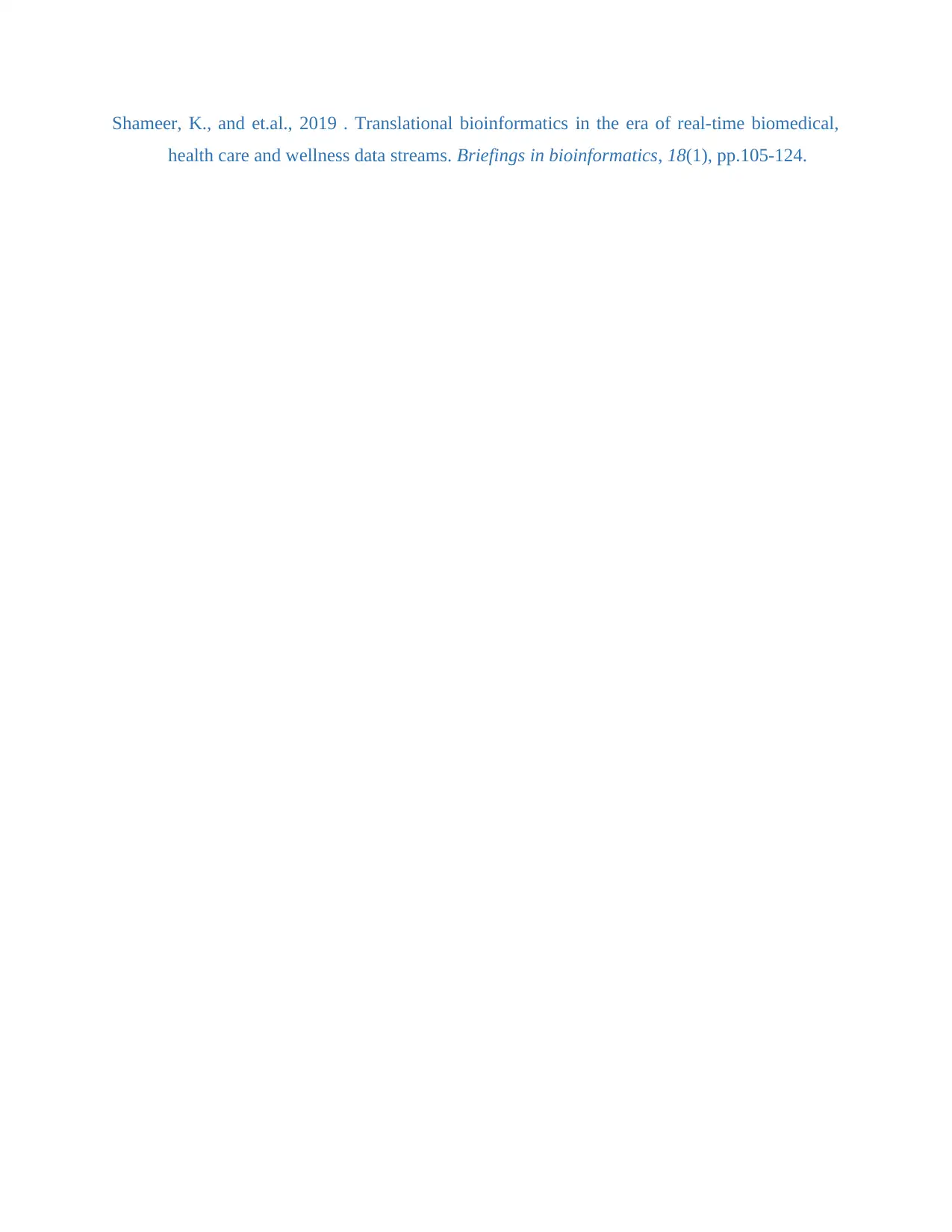
Shameer, K., and et.al., 2019 . Translational bioinformatics in the era of real-time biomedical,
health care and wellness data streams. Briefings in bioinformatics, 18(1), pp.105-124.
health care and wellness data streams. Briefings in bioinformatics, 18(1), pp.105-124.

⊘ This is a preview!⊘
Do you want full access?
Subscribe today to unlock all pages.

Trusted by 1+ million students worldwide
1 out of 9
Your All-in-One AI-Powered Toolkit for Academic Success.
+13062052269
info@desklib.com
Available 24*7 on WhatsApp / Email
![[object Object]](/_next/static/media/star-bottom.7253800d.svg)
Unlock your academic potential
Copyright © 2020–2025 A2Z Services. All Rights Reserved. Developed and managed by ZUCOL.